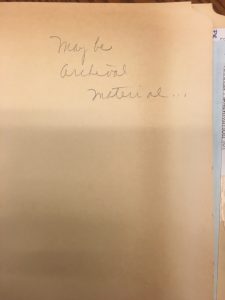 Etched in pencil on the manila folder containing the University records for the Student Organization for Black Awareness or SOBA are the words “may be archival material.” Followed by an ellipsis, those words serve as the entry point for materials concerning a group started in 1973 by black students who hoped to incorporate themselves into the university community. Their first treasurer, Norman Williams, is quoted in The Collegian as saying “‘we hope that by forming this club we can become more of a part of this university and not just another club. We want to take part in University affairs, helping out in any way we can.’” Williams and other members of SOBA emphasized that they did not intend for the group to be separatist. Instead, the founders hoped that SOBA would help black students be significantly involved in university activities. Rather than having one or two students be tokens of the community, members of the group could stand in solidarity with each other and participate in mainstream activities together.
Etched in pencil on the manila folder containing the University records for the Student Organization for Black Awareness or SOBA are the words “may be archival material.” Followed by an ellipsis, those words serve as the entry point for materials concerning a group started in 1973 by black students who hoped to incorporate themselves into the university community. Their first treasurer, Norman Williams, is quoted in The Collegian as saying “‘we hope that by forming this club we can become more of a part of this university and not just another club. We want to take part in University affairs, helping out in any way we can.’” Williams and other members of SOBA emphasized that they did not intend for the group to be separatist. Instead, the founders hoped that SOBA would help black students be significantly involved in university activities. Rather than having one or two students be tokens of the community, members of the group could stand in solidarity with each other and participate in mainstream activities together.
SOBA was formed five years after the arrival of the University’s first black residential student, Barry Greene, in 1968. At the time black students made up less than one percent of the entire student body and struggled for inclusion. At that point, the university administration had not created an infrastructure to support their needs as a minority group on campus. The black students’ decision to form SOBA did not exist in a vacuum but rather in the context of other black students that desegregated predominately white institutions across the country in the late 60s and early 70s who formed similar groups. SOBA’s first president, Stanley Davis, claimed that the group sought to “make students on campus aware about blacks and what they stand for.” They adopted the language of assimilation in order to carve out a space for themselves on the university landscape that they palpably felt did not exist.
The aforementioned folder containing documents related to SOBA primarily includes correspondence between university administrators about the group. The correspondence takes on an apprehensive tone that reflects the hesitance administrators had in dealing with SOBA. In one memo, President Heilman worried the group would take on an adversarial role and in another William Leftwich, vice president of student affairs, feared the group lacked “real purpose and goals.” Other documents containing marginalia note black student suggestions for space for SOBA in the Commons and meetings with administrators. Had these documents not been archived we would have lost the record of these relations. We would have lost the background and context for events that matter to the narrative of SOBA’s existence. The fact that someone would question the enduring value of these documents underscores a larger problem with traditional archives writ large. The voices of marginalized people are not viewed as worthy enough for preservation. This case is a bit different because the voices of SOBA members are not explicitly present but the documents still provide context for the group’s formation and its relation to university administrators.
